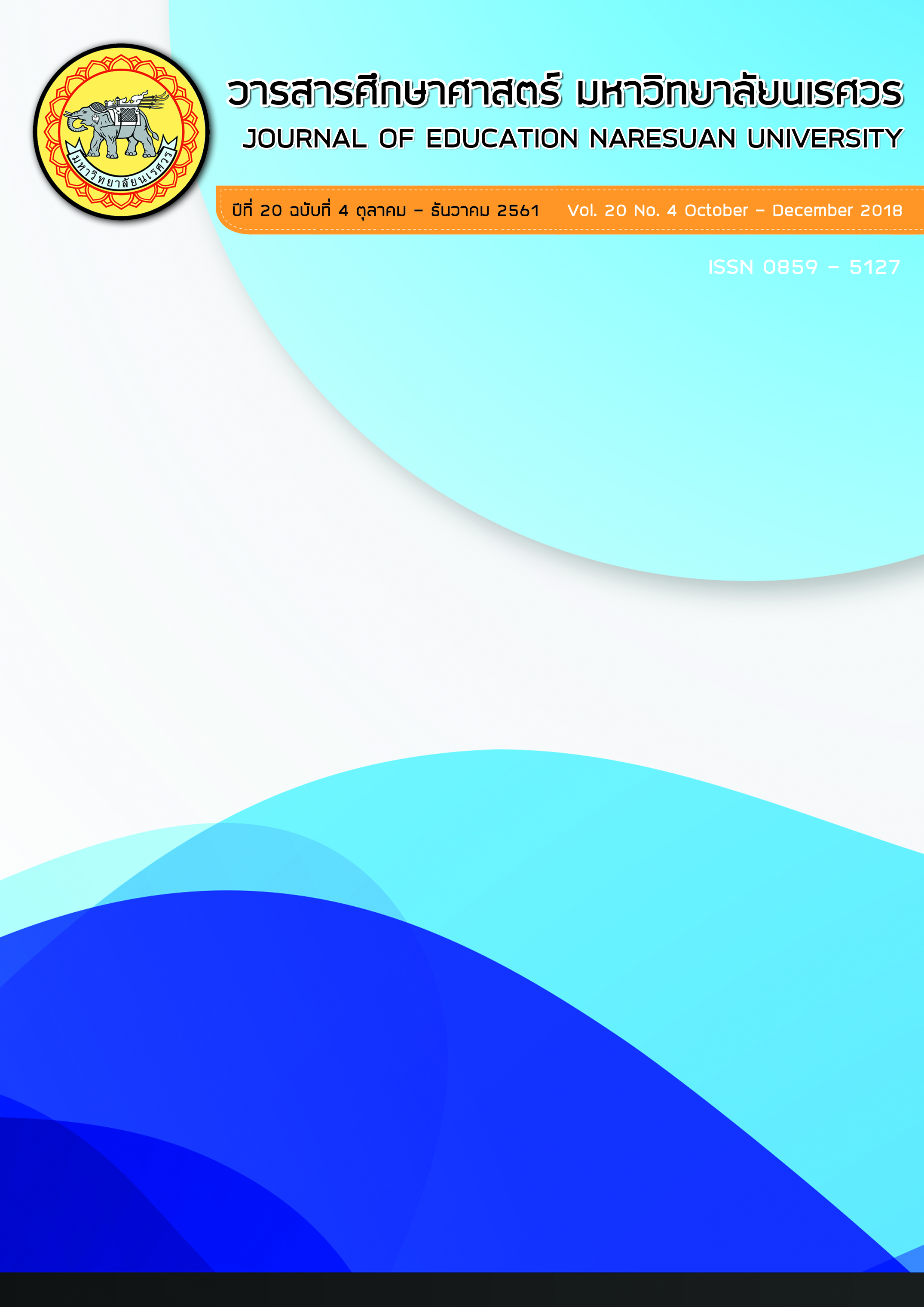การใช้การสอนภาษาที่เน้นคำศัพท์เพื่อเพิ่มพูนความสามารถในการอ่านและการเขียนภาษาอังกฤษ ของนักเรียนชั้นมัธยมศึกษาปีที่ 5; USE OF LEXICALLY-BASED LANGUAGE TEACHING TO ENHANCE ENGLISH READING AND WRITING ABILITIES AMONG MATHAYOMSUKSA 5 STUDENTS
Main Article Content
Abstract
การวิจัยครั้งนี้มีวัตถุประสงค์ 1) เพื่อเปรียบเทียบความสามารถในการอ่านภาษาอังกฤษของนักเรียน ก่อนและหลังการสอนภาษาที่เน้นคำศัพท์ 2) ศึกษาความสามารถในการเขียนภาษาอังกฤษ ของนักเรียนหลังการสอนภาษาที่เน้นคำศัพท์ กลุ่มเป้าหมายที่ใช้ในการวิจัยครั้งนี้ เป็นนักเรียน ชั้นมัธยมศึกษาปีที่ 5/4 โรงเรียนแม่สะเรียง “บริพัตรศึกษา” อำเภอแม่สะเรียง จังหวัดแม่ฮ่องสอน ที่เรียนวิชาภาษาอังกฤษเพื่อการสื่อสาร 4 (อ32204) ในภาคเรียนที่ 2 ปีการศึกษา 2558 จำนวน 37 คน เครื่องมือที่ใช้ในการวิจัยประกอบด้วยแผนการจัดการเรียนรู้การสอนภาษาที่เน้นคำศัพท์ จำนวน 7 แผน แผนละ 3 ชั่วโมง เครื่องมือที่ใช้ในการเก็บรวบรวมข้อมูล ได้แก่ แบบทดสอบ วัดความสามารถในการอ่านภาษาอังกฤษ และแบบประเมินความสามารถในการเขียนภาษาอังกฤษ ผู้วิจัยนำข้อมูลที่ได้มาวิเคราะห์หาค่าเฉลี่ย ส่วนเบี่ยงเบนมาตรฐาน และค่าร้อยละ ผลการวิจัยสรุปได้ ดังนี้
1. ความสามารถในการอ่านภาษาอังกฤษ หลังเรียนโดยใช้การสอนภาษาที่เน้นคำศัพท์ สูงกว่าก่อนเรียน
2. ความสามารถในการเขียนภาษาอังกฤษ หลังเรียนโดยใช้การสอนภาษาที่เน้นคำศัพท์ ผ่านเกณฑ์ในระดับดี
USE OF LEXICALLY-BASED LANGUAGE TEACHING TO ENHANCE ENGLISH READING AND WRITING ABILITIES AMONG MATHAYOMSUKSA 5 STUDENTS
The purposes of this research were: 1) to compare the students’ English reading ability before and after they were taught using lexically-based language teaching activities 2) to study students’ English writing ability after they were taught using lexically-based language teaching. The target group of this research was 37 Mathayom Suksa 5/4 students enrolled in English for communication (E32204) during the second semester of the academic year 2015 at Maesariang Boripat Suksa School, Maesariang District, Maehongson Province. The research instruments consisted of seven lesson plans, English reading ability test and English writing ability evaluation form. The data were analyzed for mean, standard deviation and percentage. Research findings were as follows;
1. The students’ English reading ability increased after they were taught using lexically-based language teaching.
2. The students’ English writing ability passed the pre-set criteria after they were taught using lexically-based language teaching.
Article Details
The owner of the article does not copy or violate any of its copyright. If any copyright infringement occurs or prosecution, in any case, the Editorial Board is not involved in all the rights to the owner of the article to be performed.
References
Chaikum, B. (2010). Use of the lexical approach through computer-assisted instruction to enhance English vocabulary knowledge and reading comprehension of Mathayomsuksa 2 students (Master thesis). Chaing Mai: Chaingmai University. (in Thai)
Handbook I: Cognitive Domain. New York: David Mackey Company.
Conzette, J. (2000). Language in the lexical approach. In Teaching Collocation: Further Developments In the lexical Approach, Michael Lewis (ed.), 70-86. Hove: Language Teaching Publications.
Hill, J. (2000). Language in the lexical approach. In Teaching Collocation: Further Developments In the lexical Approach, Michael Lewis (ed.), 47-67. Hove: Language Teaching Publications.
Jacobs, H. L., et al. (1981). Testing ESL composition: A practical approach. Massachusettes: Newbury House.
Kala, P. (2012). Collocation instruction to enhance English vocabulary knowledge and writing ability among Mathayomsuksa 5 students (Master thesis). Chaing Mai: Chaingmai University. (in Thai)
Khuhapinant, C. (1999). Reading techniques. Bangkok: Burapasarn. (in Thai)
Kranz, D. (1997). ‘Review of Michael Lewis’ book ‘Implementing the lexical approach: Putting theory into practice’, Hove UK: Language Teaching Publications’. TESL-EJ, 3(1).
Lewis, M. (1993). The Lexical approach: The state of ELT and the way forward. Hove, England: Language Teaching Publications.
Lewis, M. (2000). Language in the lexical approach. In Teaching Collocation: Further Developments In the lexical Approach, Michael Lewis (ed.), 126-154. Hove: Language Teaching Publications.
Lewis, M. (2001). Implementing the lexical approach: Putting theory into practice. Hove, England: Language Teaching Publications.
Martynska, M. (2004). Do English language learners know collocations? Institute of Linguistics, Adam Mickiewicz University. Miedzychodzka, 5, 60-371.
Office of the Basic Education Commission. (2005). The evaluation of analytical reading and writing according to Basic education curriculum B.E.2544 (A.D. 2001). Bangkok: Express Transportation Organization of Thailand. (in Thai)
Richards, J. C., & Rodgers, T. S. (2001). Approaches and methods in language teaching. Cambridge: Cambridge University Press.
Saengboon, S. (2012). English of Thai students. Retrieved July 2, 2016, from http://library.nida.ac.th/ndlib//images/PDF/eng-thaistudent.pdf (in Thai)
Schmitt, & Norbert. (2000). Key concept in ELT: Lexical chunk. ELT Journal, 54(4), 400-401.
Senchaowanich, S. (2530). Techniques for English reading skill and comprehension development for Thai students. Bangkok: Thammasat Printing house. (in Thai)
Seyyede, S., & Nona, H. (2013). The Effect of teaching collocations on Enhancing Iranian EFL Learners’ Reading Comprehension. Retrieved March 8, 2016, from http://european-science.com/jaelt/article/view/76
Silva, T. (1993). Toward an understanding of the distinct nature of L2 writing: the ESL research and its implications. TESOL Quarterly, 27(4), 657-677.
Solange, M. (2001). Teaching vocabulary to advanced students: A lexical approach. Karen’s Linguistics Issue. Retrieved March 8, 2016, from http://www3.telus.net/ linguisticsissues/teachingvocabulary.html
Sripor, P. (2007). Best English teaching method for learning management of modern teachers. Bangkok: Aksorn Charoenthat. (in Thai)
Tang, J. (2012). An empirical study on the effectiveness of the lexical approach to improving writing in SLA. Retrieved January 14, 2016, from http://ojs.academypublisher.com/index.php/jltr/article/view/jltr0303578583
Wiriyachitra, A., et al. (2011). Looking back and moving forward of English learning. Bangkok: Windows on the World. (in Thai)
Woolard, G. (2000). Collocation encouraging learner independence. In M. Lewis (ed.), Teaching Collocation: Further development in the lexical approach. London: Language Teaching Publications.
Xiulain, Y. (2008). An Experimental Study in the Lexical Approach to Improving. Retrieved March 8, 2016, from http://en.cnki.com.cn/Article_en/CJFDTOTALWYJY200803012.htm.
Zamel, V. (1983). The composing processes of advanced ESL students: Aix case studies. TESOL Quarterly, 17(2), 165-187.
Zhang, X. (1993). English collocations and their effect on the writing of native and nonnative college freshmen (Doctoral dissertation). Pensylvania: Indiana University of Pennsylvania.


